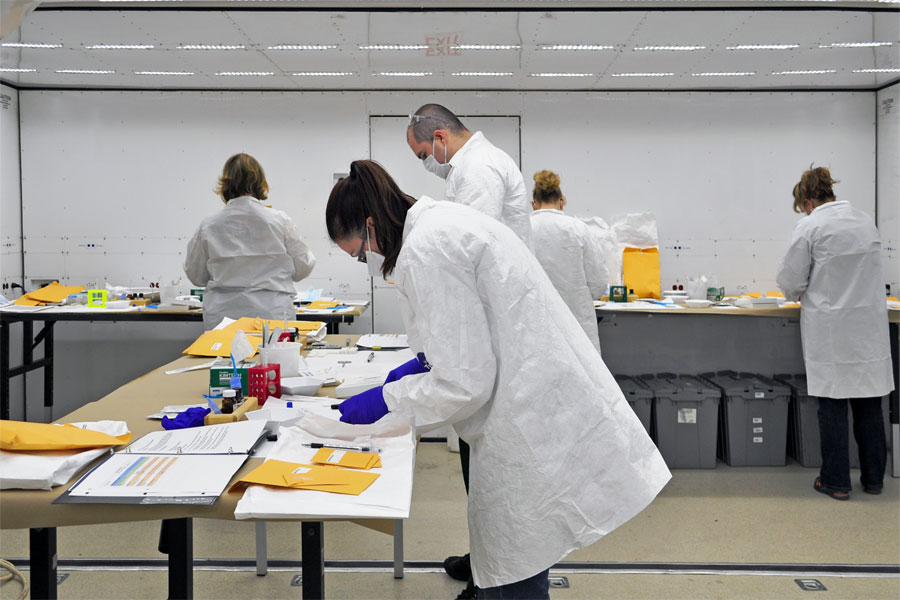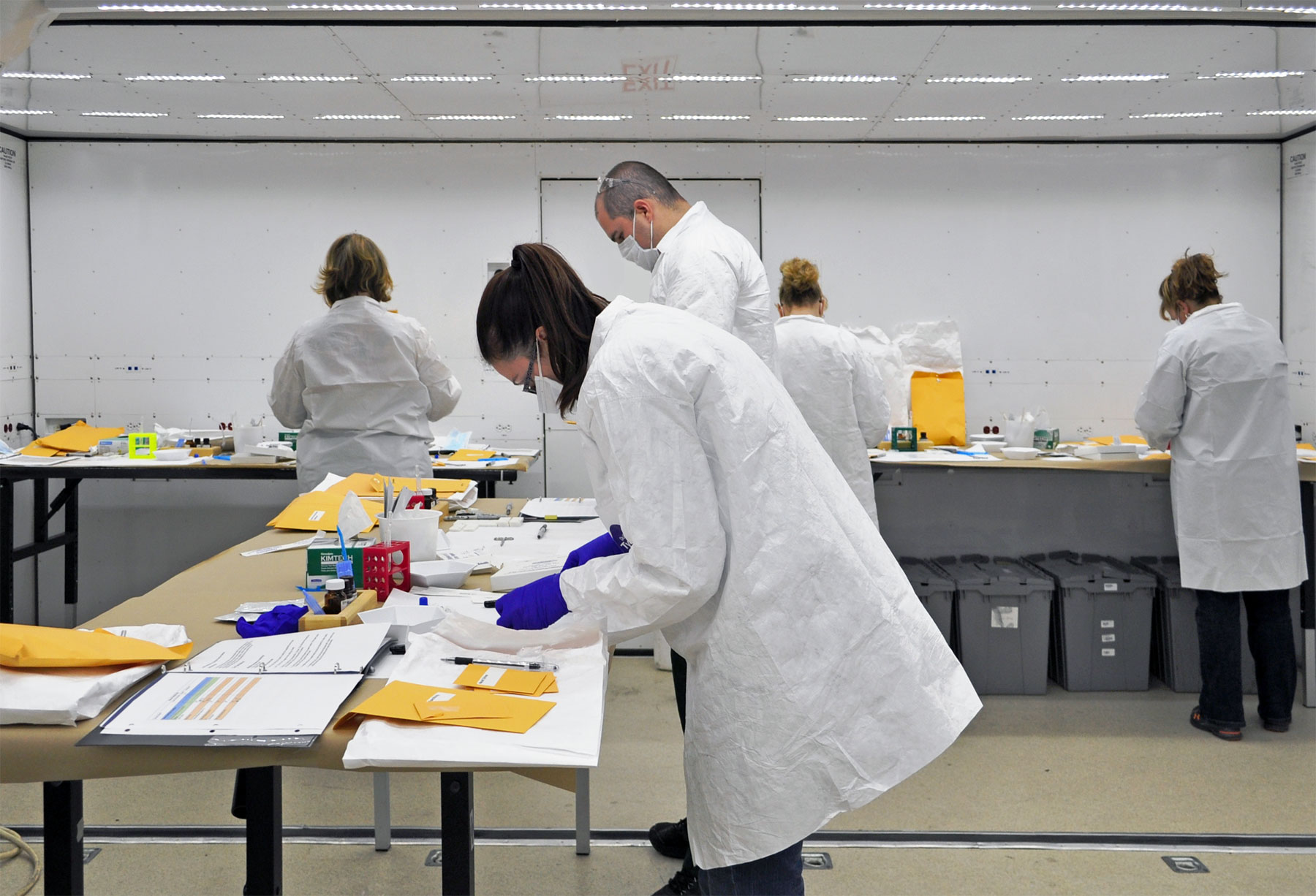In TV shows, forensic laboratories are often depicted as overly spacious, theatrically lit, and run by a single all-star technician who knows every discipline in the field who can run analysis on every piece of evidence in under 30 minutes. The reality, however, is far less glamorous. Forensic labs don’t have the ability to turn off the camera and edit out the hours it can take to prep and run a sample. In real life, forensic laboratories must be efficient and streamlined to provide the best service for the agencies they support.
GFJC focuses on training and services at Florida International University in nearly every discipline in forensic science. For nearly 30 years, the organization has worked with lab directors and analysts to create stronger forensic practices in the lab, and more efficient workflow procedures.
“Lab directors and the laboratory staff are customer-focused,” says David Sylvester, deputy director of the Global Forensic and Justice Center (GFJC). “They understand that providing optimal service to their customers is paramount. They are looking to be more efficient and reduce the case turnaround time. TV magic doesn’t exist in the lab.”
While backlogs, the amount of casework left in the queue, are often discussed in the public sector, turnaround time - how long a piece of evidence takes to go from intake to completion - can more accurately evaluate how a lab is operating. GFJC has assessed and audited more than 500 labs worldwide, seeking to make an impact on how science serves justice.
“Turnaround time is a critical metric for assessing the efficiency and responsiveness of operations. A shorter turnaround time generally reflects better efficiency and faster service delivery,” says Sylvester. According to the National Forensic Laboratory Information System (NFLIS TOX), the average toxicology testing turnaround time is 33.3 days. That means detectives may not know a person has been poisoned or was under the influence while driving for more than a month, leading to potential delays in the justice process.
When labs see their turnaround time and backlogs increase, laboratory directors can turn to GFJC for an assessment. The team reviews current workflows and potential issues and suggests attainable solutions for the laboratory.
One such lab that utilized GFJC assessment services was the Indiana State Department of Toxicology (ISDT). Laboratory director Christina Beymer wanted GFJC to give her and her staff a “fresh perspective” on how to address issues like turnaround time, backlogs, and staffing issues.
“Obviously, we always want to focus on the backlog,” Beymer says. “But really, I think the key factor is that turnaround time. Because you can have a backlog of 1,000 cases and have a turnaround time of 10 days, or you could have a backlog of 1,000 cases and a turnaround time of nine months.”
The Indiana State Department of Toxicology talks about the success in implementing suggestions from a GFJC assessment of the state-run lab.
This isn’t the first time ISDT contracted GFJC for an assessment. Twelve years ago, Sylvester led a team through the ISDT’s initial assessment after becoming a standalone state lab. The primary focus back then was to give the staff guidance to earn accreditation, which gives credence to the lab’s procedures and testing outcomes. Accredited labs must prove their testing and procedures meet international standards. “Now we need to look at how can we continue with the growth that we've had and how can we move the agency forward,” says Beymer of the lab’s 2019 accreditation achievement.
Per Sylvester, the ISDT team was highly motivated to improve their daily operations. Having staff with buy-in makes the environment more conducive to change, he says.
Some changes Beymer says were implemented fast, like how they prep samples for testing for alcohol. Previously, the technicians would prep the sample for the screen to test for the presence of alcohol. If positive, another sample would be prepped for the confirmatory test. “And part of the recommendation from the assessment team was instead of doing a screening and then doing a confirmation at another point in time to essentially prep the sample twice, do all of the analysis at one time.”
Beymer says this adjustment decreased the lab’s turnaround time for alcohol testing, calling the suggestion the biggest “bang for their buck.”
Some suggestions, like renovating the office to make space for much-needed administrative support, took more time to implement. The GFJC team noticed how much time the technical staff spent supporting administrative tasks, which took them away from the casework. Still, the office space physically limited the ability to place more workspaces to set up these positions.
“In August of 2023, I actually spoke in front of the state budget committee to get additional funding for our agency to do a laboratory renovation, an office renovation, and purchase additional instruments,” says Beymer. The GFJC final assessment report gave weight to her request because, she says, it wasn’t just the lab asking for more money it was a third party backing up the solutions that would better serve the state of Indiana.
Sylvester says there’s no one-size-fits-all mold for a successful laboratory. “Whatever recommendations are made must be realistic for the particular laboratory that is assessed.” Suggesting building an entirely new facility in a budget-restricted area, for example, won’t help set the laboratory up for success. Beymer says because of these personalized recommendations, their backlog for alcohol testing is now zero, something she says has never been done before in the lab’s history.
Beymer and her lab were awarded the American Society of Crime Lab Directors Foresight Maximus Award in May. Only 16 labs nationwide were selected for operating at 90% peak efficiency. “I'm really proud of the work that our staff have accomplished in order to achieve this award,” Beymer says. “We pride ourselves in not only doing quality work but of course, we want to do efficient work.”
The ISDT isn’t taking too long to celebrate. The lab is working on improving its cannabinoids workflow, the most extensive testing they do, by nearly doubling the amount of testing they can do at once. They will also install two mass spectrometers, purchased with the budget increase, which will be worked into their efficiency models.
“We make the best suggestions based on factors inside and outside their control,” says Sylvester. “GFJC has more than 30 years’ experience and when you match that with a motivated staff like the Indiana State Department of Toxicology, you have a recipe for success.”

